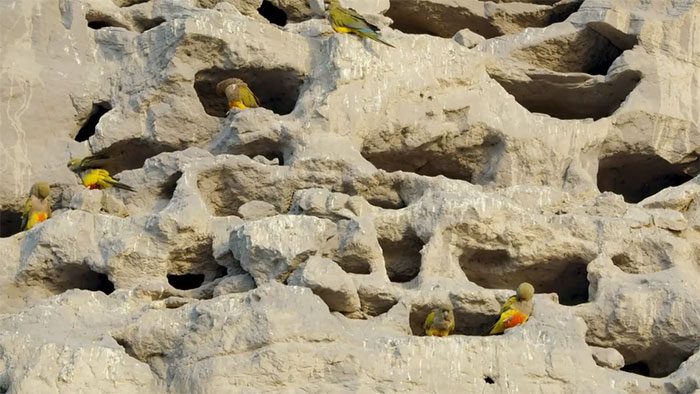The sandstone cliffs at the northern tip of the Patagonia desert are home to the largest parrot colony in the world, with 37,000 nests.
Video: CNN
The El Cóndor Cliffs serve as a nesting area for a parrot species that was once widespread across South America, but whose numbers are now declining. Their food sources in the Argentine Monte region are disappearing faster than those in the Amazon rainforest. This desert grassland and scrubland is being affected by deforestation.
The name cavity-nesting parrot comes from their behavior of building nests in sandstone cliffs. The burrows can be as deep as 3 meters. With their green feathers and white markings around their eyes, cavity-nesting parrots stand out against the cliffs overlooking the Atlantic Ocean. They must fly for three hours from their nests to find seeds and berries to bring back to their young. Each year, they travel further in search of food. It is estimated that adult parrots can fly up to 264 kilometers each day, according to scientists at Justus Liebig University in Giessen, Germany. Furthermore, threats from humans and the tourism industry in the region make survival increasingly challenging for these parrots.
Director Kevin Zaouali, who oversees the CNN program “Patagonia: Life on the Edge of the World”, and his film crew spent 20 days with the parrot colony. They noted that cavity-nesting parrots are preyed upon by the peregrine falcon, the fastest bird on the planet. Peregrine falcons can reach speeds of 386 km/h when swooping down to catch their prey. Some young parrots in the nests become curious while waiting for their parents to return with food and may fall from the cliffs if they wander too far, becoming targets for predators like falcons.

The cavity-nesting parrot colony living on the El Cóndor cliffs.
The sandstone cliffs also pose many risks to the population. Large rocks occasionally tumble down from the cliff face, killing the parrots inside. However, the parrots return each year after spending the winter in the north because they prefer the dry surfaces of the cliffs along the Atlantic coastline. Due to their vibrant plumage, cavity-nesting parrots are also hunted as pets or killed for eating crops. They are highly susceptible to disturbances from human encroachment into their habitat.
Zaouali is concerned that the largest parrot population on Earth and many other animal species may gradually disappear if the Patagonia authorities do not implement protective measures.





















































